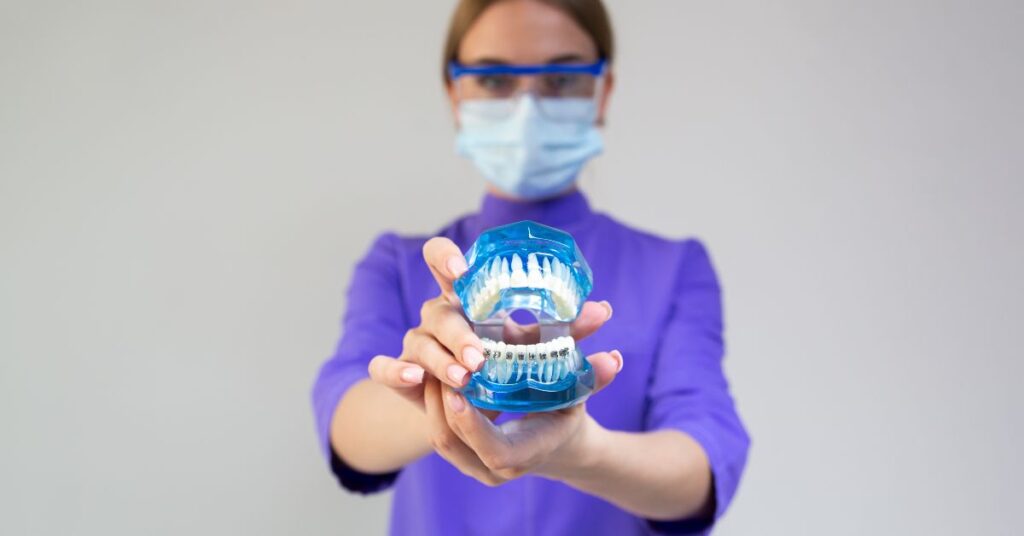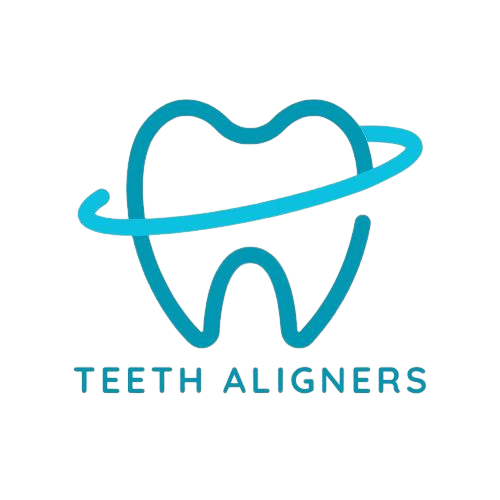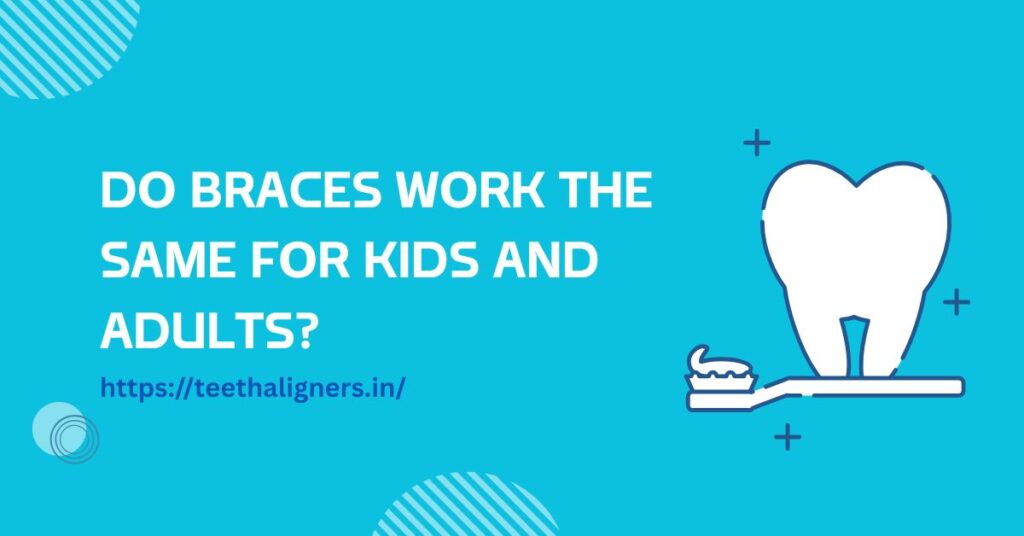When you picture someone wearing orthodontic appliances, you might immediately think of a teenager smiling with shiny wires and brackets. For many years, people believed that straightening teeth was mainly something for children or teens.
But in recent times, adults have increasingly chosen to improve their smiles with orthodontic care as well. This brings us to an interesting question: do Braces work the same way for kids and adults?The answer is both simple and layered.
Orthodontic treatments can be successful at nearly any age, but the way they work, the time they take, and the challenges patients face can vary. To understand this better, we need to look closely at growth, treatment stages, and lifestyle differences between kids and adults.
Table of Contents
ToggleWhy People Get Braces at Different Ages
Children and adults usually start orthodontic care for different reasons, even though the end goal is often the same: straighter teeth and a healthier bite.For kids, orthodontists may recommend treatment early if they notice problems with bite alignment, crowding, or jaw development.
Early care can prevent bigger issues later on. For example, a child with a severe overbite might develop uneven wear on teeth or jaw discomfort if the problem is left untreated. Addressing it during growth years makes the process easier.
Adults, however, often consider orthodontic treatment for a mix of health and cosmetic reasons. Some may have never received treatment as children and finally decide to correct their smile. Others may be experiencing gum concerns or tooth wear linked to misalignment.
Cosmetic reasons are also very common, as more adults want to feel confident in both professional and social settings. With modern options like transparent smile aligners, many adults now prefer treatment methods that are discreet, comfortable, and easy to manage in daily life.
How Growth Affects Treatment
Kids and Jaw Development
One of the most important differences between treating kids and adults is growth. Children are still developing physically, and this includes their jawbones. Because their bones are softer and more adaptable, orthodontists can guide tooth and jaw movement more easily.
The appliances apply gentle pressure, and the body responds quickly since it is still growing.For this reason, orthodontists often recommend beginning treatment between the ages of 10 and 14. During this stage, most permanent teeth have erupted, but growth is not yet complete.
This window allows orthodontists to correct issues like bite misalignment, crossbites, or spacing concerns while growth can assist in the process. For instance, guiding a growing jaw into a better position is much easier in a child than in an adult.
Adults and Mature Bones
For adults, the bones of the jaw have already hardened. This does not mean treatment won’t work,it simply means it takes longer. Since the body resists changes more than it does in childhood, teeth move at a slower pace.
On average, an adult may require additional months of treatment compared to a child with a similar issue.
In some complex cases, adults may also need extra procedures, such as tooth extractions to create space or even jaw surgery if the misalignment is severe.
While these situations can extend treatment, many adults still achieve excellent outcomes, proving that age is not a barrier to success.
Treatment Time and Process Differences
The length of orthodontic treatment can vary widely, but there are general trends when comparing kids and adults.Children typically complete treatment more quickly, often within 18 to 24 months.
Because their teeth and jaws are developing, the appliances can guide them more efficiently. This speed is one of the advantages of starting treatment young.
For adults, treatment may extend to 24 to 36 months. However, the difference is not always due to tooth movement speed. Adults often present with other dental challenges, such as past fillings, gum issues, or missing teeth, which need careful management. These conditions can make the process more involved.
Despite the timeline differences, the actual process is very similar for both kids and adults. Brackets are placed on the teeth, wires are adjusted at regular intervals, and the orthodontist monitors progress carefully. Patience and consistency are important at every age.

Comfort and Lifestyle Considerations
Kids and Adjustment Challenges
For children, one of the hardest parts of wearing orthodontic appliances is adjusting to new routines. Wearing them at school may cause initial discomfort or self-consciousness.
Some children may worry about teasing or feel shy when smiling. Parents and orthodontists often play an important role in building their confidence by showing the long-term benefits.
Children also need reminders to brush carefully and avoid sticky foods like gum and candy that could damage the appliances. Regular appointments and cooperation are essential to keeping treatment on track. With encouragement and support, most kids adapt well after the first few months.
Adults and Social/Work Concerns
Adults often face challenges of a different kind. They may worry about their appearance in professional settings, such as during presentations, client meetings, or interviews.
Social events may also feel more difficult during the adjustment phase. For these reasons, many adults prefer more discreet options, such as ceramic brackets or clear aligners.
Unlike kids, adults are usually better at following care instructions. They are often more disciplined about cleaning and wearing elastics when required.
However, their busy schedules can sometimes make it harder to attend regular appointments. Balancing work, travel, and family life with orthodontic treatment can require extra effort.
Long-Term Results for Kids vs. Adults
In the end, both children and adults can enjoy excellent long-term results from orthodontic care. The main difference lies in how stable those results are without consistent follow-up.
For children, treatment works hand in hand with growth. As the jaw develops, orthodontists can guide it into the right position, making the final results more natural and stable. With proper retainer use, children often maintain their straight teeth well into adulthood.
Adults also achieve strong, lasting results, but they must be especially diligent with retainers. Since their jaws have already matured, the teeth have a stronger tendency to drift back toward their original positions.
This is why many orthodontists recommend lifelong retainer use, at least several nights a week.In both groups, retainers are the key to long-term success. Without them, even the best treatment can relapse over time.
Common Myths About Braces and Age
There are several common myths surrounding orthodontics that can discourage people, especially adults, from starting treatment.One common myth is that braces do not work for adults.
This is far from true. Thousands of adults undergo orthodontic treatment each year with excellent results. The process may take longer, but the effectiveness remains the same.
Another myth is that kids always complete treatment faster. While it is often the case, some children require longer care depending on the severity of their issues. Every patient’s timeline is unique.
A third myth is that orthodontics is only for appearance. In reality, properly aligned teeth make it easier to chew, speak, and maintain healthy gums. Misalignment can contribute to gum disease, tooth wear, and even jaw discomfort. Correcting these issues benefits both health and confidence.
Dispelling these myths is important because they can prevent people from making decisions that could greatly improve their oral health.
The Role of Modern Dentistry
Modern orthodontics has advanced greatly compared to past decades. Appliances today are smaller, lighter, and more comfortable. Gentle wires reduce discomfort, and advanced materials make brackets less noticeable. Clear aligners have become especially popular among adults who prefer a nearly invisible option.
Technology has also changed the way orthodontists plan treatment. Digital scans replace messy impressions, giving precise images of the teeth. Computer programs can show patients a preview of their final results before treatment even begins.
These tools improve accuracy and make the process smoother for both children and adults.In growing urban centers such as Delhi, orthodontic practices now offer a wide variety of choices to meet the needs of different patients.
Whether a child starting early or an adult finally correcting long-standing issues, modern dentistry provides effective solutions that fit individual lifestyles.
Clinics like our combine advanced technology with patient-centered care, helping families make confident choices about orthodontic treatment.
Conclusion
So, do orthodontic treatments work the same way for kids and adults? The answer is yes,both groups can achieve straight teeth and healthier smiles. The main differences lie in growth, treatment time, and lifestyle adjustments.
Children benefit from natural jaw development, making changes easier and sometimes faster. Adults may require longer treatment and, in some cases, additional procedures, but the results are just as rewarding.
Whether the goal is to improve health, boost confidence, or prevent future dental issues, orthodontics remains a reliable option at any age.
For families and individuals exploring treatment options, Teeth Aligners in India provides guidance and modern care that helps patients achieve lasting smiles with confidence.

